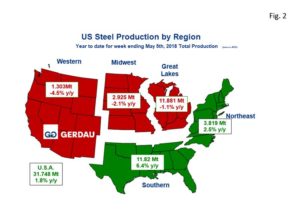U.S. Steel Capacity Utilization
The total tonnage for the week ending May 5th was 1,779 million tons, (Mt) at a capacity utilization rate of 75.9%. For the first 18 weeks of 2018, total tonnage output was 31,748 Mt, at an average capacity utilization rate of 75.6%. In 2017, the same 18 weeks production total was 31,196 Mt at 73.4%. Thus volume was up 1.8% year on year, (y/y), while capacity utilization was higher, up 2.7 percentage points.
 Figure 1 shows production on the left-hand scale and capacity utilization as a percent on the right-hand scale. Capacity utilization and production tapered off compared to this time last month, down 1.1 percentage points and 1.4% m/m respectively.
Figure 1 shows production on the left-hand scale and capacity utilization as a percent on the right-hand scale. Capacity utilization and production tapered off compared to this time last month, down 1.1 percentage points and 1.4% m/m respectively.
Figure 2 presents a map of the U.S. with its five steel producing zones. The nation as a whole produced 1.8% more steel than for the same period in 2017. The Great Lakes region was the largest steel producing region, with 11.881 Mt through May 5th, down 1.1% y/y. The Southern region habitually the second largest, produced 11.82 Mt up 6.4% y/y. At 3.819Mt, the Northeast region ranked third largest. The Northeast tonnage moved-up by 2.5% y/y. The Midwest produced 2.925 Mt, down 2.1% y/y, while the Western zone produced 1.303 Mt, down 4.5% y/y.
presents a map of the U.S. with its five steel producing zones. The nation as a whole produced 1.8% more steel than for the same period in 2017. The Great Lakes region was the largest steel producing region, with 11.881 Mt through May 5th, down 1.1% y/y. The Southern region habitually the second largest, produced 11.82 Mt up 6.4% y/y. At 3.819Mt, the Northeast region ranked third largest. The Northeast tonnage moved-up by 2.5% y/y. The Midwest produced 2.925 Mt, down 2.1% y/y, while the Western zone produced 1.303 Mt, down 4.5% y/y.
Looking at raw steel production on a twelve month moving total, (12MMT) basis, we see that; The Great Lakes region produced 34,091 Mt, up 2.8% y/y. The Southern zone made 33,450 Mt, up 8.9% y/y. The Northeast region produced 10,825 Mt for a 2.8% increase y/y. The Midwest generated 8,510 Mt, down 0.1% y/y. The Western region produced 3,782 Mt, 2.3% lower on a y/y basis. Total U.S. production, (12MMT) was 90,658 Mt, up 3.2% y/y.
At Gerdau, we track US steel production and capacity utilization to keep an eye on the overall health of the US steel industry. We feel it is important to understand the forces that influence steel demand to include the strength of the US economy and import penetration.

